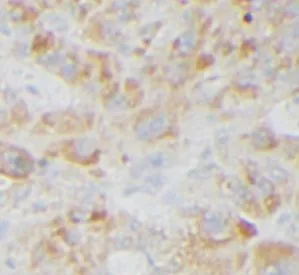HDAC3 antibody - 100 µg
Host : Rabbit
Clonality: Polyclonal
Clone:
Isotype: IgG
Immunogen: histone deacetylase 3
Purity: ≥95% as determined by SDS-PAGE
Form: Liquid
Molecular weight: 47 kDa
Uniprot: O15379
Gene id: 8841
Background: Histones play a critical role in transcriptional regulation, cell cycle progression, and developmental events. Histone acetylation
deacetylation alters chromosome structure and affects transcription factor access to DNA. The protein encoded by this gene belongs to the histone deacetylase
acuc
apha family. It has histone deacetylase activity and represses transcription when tethered to a promoter. It may participate in the regulation of transcription through its binding with the zinc-finger transcription factor YY1. This protein can also down-regulate p53 function and thus modulate cell growth and apoptosis. This gene is regarded as a potential tumor suppressor gene.
Field of research: Epigenetics, Cardiovascular, Metabolism
Storage conditions: PBS with 0.02% sodium azide and 50% glycerol pH 7.3, -20°C for 12 months (Avoid repeated freeze
thaw cycles.)
Applications: ELISA, IHC, IP, WB, IF
Dilution: WB: 1:500 - 1:2000; IHC: 1:50 - 1:100; IF: 1:50 - 1:200; IP: 1:50 - 1:200; ChIP: 1:20 - 1:100
Target: HDAC3
Purification: Immunogen affinity purified
Reactivity: Human, Mouse, Rat

Clonality: Polyclonal
Clone:
Isotype: IgG
Immunogen: histone deacetylase 3
Purity: ≥95% as determined by SDS-PAGE
Form: Liquid
Molecular weight: 47 kDa
Uniprot: O15379
Gene id: 8841
Background: Histones play a critical role in transcriptional regulation, cell cycle progression, and developmental events. Histone acetylation
deacetylation alters chromosome structure and affects transcription factor access to DNA. The protein encoded by this gene belongs to the histone deacetylase
acuc
apha family. It has histone deacetylase activity and represses transcription when tethered to a promoter. It may participate in the regulation of transcription through its binding with the zinc-finger transcription factor YY1. This protein can also down-regulate p53 function and thus modulate cell growth and apoptosis. This gene is regarded as a potential tumor suppressor gene.
Field of research: Epigenetics, Cardiovascular, Metabolism
Storage conditions: PBS with 0.02% sodium azide and 50% glycerol pH 7.3, -20°C for 12 months (Avoid repeated freeze
thaw cycles.)
Applications: ELISA, IHC, IP, WB, IF
Dilution: WB: 1:500 - 1:2000; IHC: 1:50 - 1:100; IF: 1:50 - 1:200; IP: 1:50 - 1:200; ChIP: 1:20 - 1:100
Target: HDAC3
Purification: Immunogen affinity purified
Reactivity: Human, Mouse, Rat

